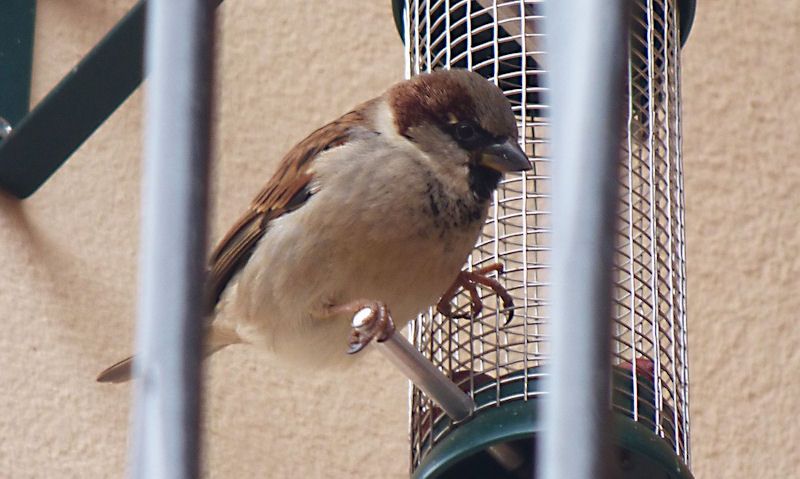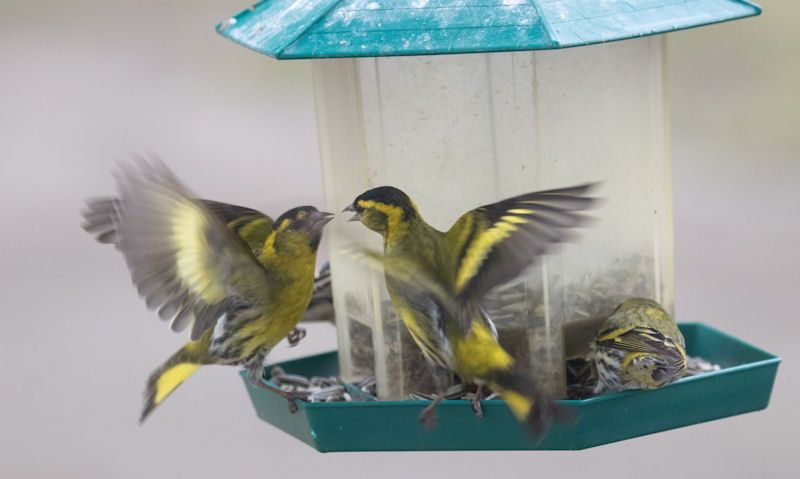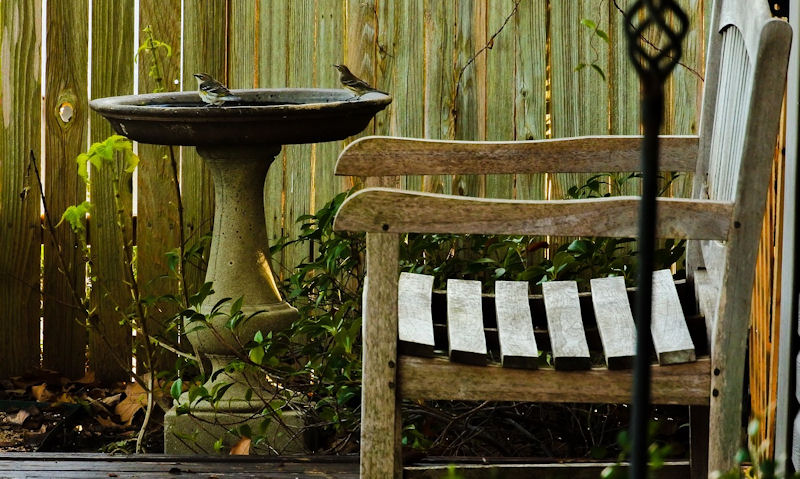Bird feeder placement guide
Where you place a bird feeder will have its telling over a period of days or weeks, and if no bird takes to it, its time to switch position.
Bird feeder placement for all types of feeders is vital for both attracting wild birds well keeping the food in perfect condition. Keep it in of the shade if you have to but always close by to trees, shrubs or plantation as natural cover for the birds. Protecting the feed from the elements relies on a covered bird table.
Before setting up a bird table or hanging up a feeder you must do the following as you'll find it hard to get birds to feed in a safe and secure surrounding.
Consider the clear line of sight with a suitable flight path; so place it out in the open and not undercover.
Its worthwhile you setup a feeder to view from your window, but don't position it to close as to disturb them every time they attempt to eat.
Keep bird feeders further back but always with plantation nearby.
Food contained within feeders need to be looked after, so a shaded area would make sense, though bird feed is usually formulated to withstand outdoors.
To which, most food gets eating within a few days anywhere with a busy feeding station.
Clear line of sight
Clear line of sight is an important factor when birds feed, as they come in to grab a bit of food before retreating back before returning again.
Whatever standalone bird feeder, table or complete feeding station you go for, placing it in part of the garden that has a clear line of sight, and a clear flight path is vital.
Well a clear line of sight allows them to see what's on offer before committing, the clear flight path is required as they fly across to the feeder.
They will manage quite well through nature but make sure they don't have to pass over a patio or walk way that's often occupied by people.
Where in your garden
Consider setting up a bird table on a stand or a bird feeding station central to your garden lawn, as it looks the most attractive position.
When this doesn't work its probably because there's lack of natural cover nearby.
Sacrificing a central location over an appropriate site would stop birds making the most of the feeder, so set it up for them in a safe environment over your own needs.
Take our advice for where to place a bird bath in the garden; same rules apply with plenty of blooming flowers, trees, shrubs and hedgerows needed within a metre or two.
Viewing from window
Regardless of the setup you've chosen, when it comes down to it you'd probably want a first class seat of the action which happens through your window.
If birds are not using the bird feeder it could be because the location you've selected for your own benefit is not suited for wild birds.
Pull the feeder to close to the house and they will be kept away from noise or movement.
Though moving it further away may not be the answer as you'll push it to far away from the trees, bushes and shrubs.
Positioning the bird table or stand in the centre of the lawn would be a start; then move it left or right, back or forwards as required by the birds over time.
Hanging feeders
Much of the bird feeders that are currently on offer are made to be hanged off a bracket or for use with a bird feeding station.
If you're not using a standard feeding station the garden opens up many effectives ideas for hanging a bird feeder in a safe but interesting way.
Though we have to say the hanging of a bird feeder off a metal or wooden bracket on the house brick wall is the safest option and can be very effective.
If you have a tree in the garden then there's no better way than hanging it off a solid branch that opens up for a clear flight path beneath it.
But this area should not be frequented by cats or squirrels under no circumstances.
You could also hang the feeder off a garden gazebo, trellis or even a washing line when its not in use.
Keeping squirrel or pigeons out
Understand wherever you decide to place the bird feeder it all comes down to keeping the squirrels or pigeons out.
For most of us keeping pigeons off the bird feeder is a problem, well only those houses sited around wooded areas usually have squirrel issues.
In any case you'd want to use anti-deterring, squirrel proof bird feeder surrounded in a cage or similar devices for keeping them away.
If all else fails, site the feeder high up on the house bricks to keep the squirrels away.
To keep pigeons away you could make the feeder smaller by which you would hang it closer to the wall to make it difficult for pigeons to perch.
Bird table
Bird tables are built because they offer the most solid structure for offering wild birds food all you round, under the cover of a roof.
And its this roof that would retain the quality of the feed as it keeps the rain and even the snow away, and well it won't keep it damp proof, it would at least keep the wet off.
Well an open bird table could be offered during the dryer months, you could go for a more reliable mounted table to be fixed to a wall or fence post, or the favourite traditional wooden bird table on a stand.
Mounted bird tables
Mounted bird tables are those that have the table top but are without the post below it.
Instead you get a wall or fence mounted feature on the designated backside which is the side that is pushed up again the wall or fence.
Often made from wood so can be quite heavy, so if using a fence post make it a solid one with additional screws used if possible.
Hanging bird tables
Again, just the best part of the table top with roof with no stand or features to fix to a post or wall, instead it has either a fancy rope or chain to hang up.
Most common area to fix a traditional wooden hanging bird table would be off a strong tree branch, as overhang elsewhere in the garden is limited for use with a big hanging bird table like this one.
Where the usual peanut or seed feeders are hung, they're not suitable for hanging bird tables.
If you have a tree for an heavy, large hanging bird table then go for it; if not, we simply can't think of anywhere else you could hang such a table.
Stand bird tables
Traditional wooden bird tables on a stand along with legs to stabilise are your best bet for setting up a hard wearing, long lasting bird table in your garden.
Assembly is required for brands that require you to put it together yourself, though look to proper, high quality producers of bird tables if you want one that doesn't need assembling.
Feeding station on pole
If you're setting up a complete, all in one bird feeding station on a pole then you're going to need to position it in an area in the garden that provides you access around it.
Allowing one-sided access would limit your ability to hang the feeders appropriately, which in turn would restrict your access for cleaning up time.
When siting a bird feeding station on a base or pole, try to position in the middle of the lawn, patio or decking if still near by to trees or plantation.
Remember, it doesn't have to be an expensive complete bird feeding station that has multiple brackets and hooks for a four or more feeders.
You could instead opt for a single use hanging bird feeder pole with just one bend on the pole that will fit a single hanging feeder on the end.
It could also be a pole that needs to be impaled into the ground, or more interestingly, a pole on a weighted base so you can place the feeder on the patio or decking.
Fat ball feeder
Fat balls in bird feeder will keep for days in the feeder regardless of the hot or cold weather, and wherever you hang it should be suitable.
Don't be afraid of the lard that binds the seed and peanut from melting, it will make little mess in the feeder and shouldn't melt at all.
Fat balls are a pretty reliable source of food for hanging bird feeders, and in fact are one of the top food to be eaten first, often within a day or two, so this won't often be an issue.
Fat ball feeders can be hung along with all other feeders with no problems.
Dried mealworm feeder
If selecting an hanging dried mealworm feeder for wild birds in a clear plastic tube, it would fit in fine on the bird feeding station next to the peanut and seed feeder.
Though if you're using one of those mealworms feeders for the live or dried option, this often covered mesh tray will need room to spread out.
So it might be a good idea to isolate this feeder on its own bracket away from other feeders, though it would still have to be kept close by as to not be out of sight.
Nut, Peanut feeder
Probably the most favourite bird feeder in the garden for small British garden birds, this long or short mesh design feeder could be hung anywhere with great success.
Similar but not identical to the often fatter, shorter nut feeder, allow enough space around the mesh casing for the birds to cling to the side in all directions.
If you can, on the bird feeding station move the peanut bird feeder to the one side well doing your best to move all other feeders to the other.
Placement of the peanut feeder should be prioritised as its a great source of protein for a large range of birds, so should be easily accessible.
Seed feeder
Seed mixes that are inserted into a plastic seed feeder tube can become sticky and clung together when left in a tube for to long.
This is usually from the sun heating up the seed oil before drying up and sticking.
If you can it may be best to keep the seed bird feeder in the shade; the autumn, winter and spring months would be fine for all other times when the sun is not so strong.
Seed mixes are quite advanced these days to withstand what the weather can throw at it, so there's no reason why you shouldn't hang it up wherever the peanut feeder is.
Window feeder
Obviously the placement of a window feeder goes on the window. Easily said than done when the only window in your house is undesirable to birds.
To attract birds to the window feeder you'll need to simply stick the feeder on the window and hope for the best.
Its a tough one as the use of a window feeder doesn't always work or guaranteed.
And well time and patience is needed, you're sure to get a few nibbles once in while, especially from the smaller Tits, Robins and sparrows.
To which you will have to stay quiet indoors with no movement.
Ground feeder
Placement of a ground bird feeder is not a simple case of putting it anywhere on the lawn, patio or decking.
This often secluded bird feeder should be pushed back into shrubs or plantation to create a natural, safe environment, which is especially true for stone effect feeders.
If using a metal, mesh designed ground feeder on legs don't take the name in the product title literally.
Ideally you'd want to place the ground bird feeder higher up on a wall or perhaps garden furniture like an outdoor table.
On the ground it will still work well attracting ground feeding birds that would usually eat worms and insects, though its safer when located higher up.
Bird feeding trays
When we talk about a bird feeding tray we're talking about those ones that are either fixed to the bird feeding pole, or ones hanging off a bracket on chains.
For the ones that need fixing to a pole, you should think about placing it as high up the pole as possible as to avoid the birds pooing in it from above.
With a hanging bird feeding tray you'd want to hang this to a bracket on a wall or fence post on its own, as the shape and size doesn't allow for much room on the feeding station, though a single bracket pole would be ideal.
Conclusion
So there you have it. All types of hanging bird feeders can be group close by well the wider ones need to be isolated on there own bracket.
And well bird food that is used to fill up the feeders can go stale or rot if stored in a feeder that is open to the sun, they're usually produced to withstand these conditions.
If a single bird feeder hung up on a wall bracket is a preferred choice, then locate it on the brick wall of the house to keep squirrels or pigeons away.
If you must go for an all in one feeding system, then locate in the middle of the lawn for easy access by you, but still within a metre or so to nearby plantation.
Finally, a wooden bird table on a stand should be located centrally also, but with this feeder you get the bonus of the feed being protected from rain with shade from the sun.


